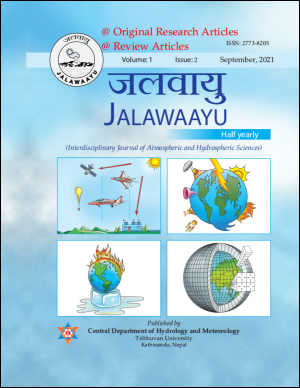Dynamics of Lower-Barun Glacier and Glacial Lake and its GLOF Susceptibility Using Geospatial Analysis and Modelling
DOI:
https://doi.org/10.3126/jalawaayu.v1i2.41012Keywords:
Lower-Barun, Glacier, GLOF, Susceptibility, ModellingAbstract
Shrinkage of some of the glaciers has direct impacts on the formation and expansion of glacial lakes. Sudden glacial lake outburst floods (GLOFs) are a major threat to lives and livelihoods downstream as they can cause catastrophic damage. In this study, we present the dynamics of the Lower-Barun glacier and glacial lakes and their GLOF susceptibility. We used multi temporal Landsat and Sentinel satellite imagery and extracted the lake outlines using the Normalized Difference Water Index (NDWI) with manual post-correction while the glacier outline was digitized manually. Multi-criteria decision-based method was used to assess the GLOF susceptibility. For the estimation of peak discharge and failure time, an empirical model developed by Froelich (1995) was used. The surface area of the Lower-Barun glacial lake was increased by 86% in the last 40 yrs (from 1979 to 2018), with a mean increase of 0.0432 km2/yr. The shrinkage in the glacier area is around 0.49 km2/yr and has shrunk by 8% in the last four decades. The retreat of the Lower-Barun glacier was 0.20% per year in the last four decades. The susceptibility index was 0.94, which suggests that the lake is very highly susceptible to the GLOF. The peak discharge of 5768 m3/s is produced when the breach depth is 20 m and the entire water volume is released. Likewise, in the case of 15 m breach depth, the peak discharge of 4038 m3/s is formed. Breach depth scenario of 10 m, peak discharge of 2442 m3/s is produced and in case of breach depth of 5 m produces the peak discharge of 1034 m3/s. If GLOF occurs, it can exert disastrous impacts on the livelihood and infrastructure in the downstream. So, it is necessary to examine such lakes regularly and mitigation measures to lower the GLOF susceptibility should be emphasized.
Downloads
Downloads
Published
How to Cite
Issue
Section
License

This work is licensed under a Creative Commons Attribution 4.0 International License.
Copyright © of the articles is held by the authors.

